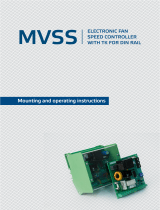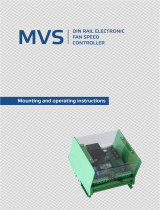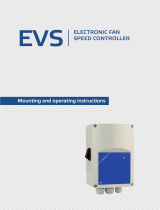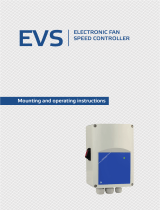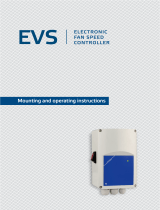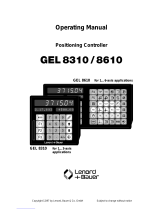Page is loading ...

Mounting and operating instructions
MVS ELECTRONIC FAN
SPEED CONTROLLER
FOR DIN RAIL

www.sentera.eu
MIW-MVS-EN-001 - 21 / 06 / 2016 2 - 16
Table of contents
SAFETY AND PRECAUTIONS 3
PRODUCT DESCRIPTION 4
ARTICLE CODES 4
INTENDED AREA OF USE 4
TECHNICAL DATA 4
STANDARDS 5
WIRING AND CONNECTIONS 5
OPERATIONAL DIAGRAMS 6
MOUNTING INSTRUCTIONS IN STEPS 8
VERIFICATION OF INSTALLATION INSTRUCTIONS 10
OPERATING INSTRUCTIONS 11
MODBUS REGISTER MAPS 12
TRANSPORT AND STOCK KEEPING INFORMATION 16
WARRANTY INFORMATION AND RESTRICTIONS 16
MAINTENANCE 16
MVS ELECTRONIC FAN SPEED CONTROLLER
FOR DIN RAIL

www.sentera.eu
MIW-MVS-EN-001 - 21 / 06 / 2016 3 - 16
back to the table of contents
SAFETY AND PRECAUTIONS
Read all information, the datasheet, mounting instructions and wiring scheme
before working with the product. For personal and equipment safety, and for
optimum product performance, make sure you entirely understand the contents
before installing, using, or maintaining this product.
For safety and licensing (CE) reasons, unauthorised conversion and/ or modifications
to the product are not permitted.
e product must not be exposed to abnormal conditions, such as: extreme
temperatures, direct sunlight or vibrations. Chemical vapours with high concentration
in combination with long exposure times can affect the product performance. Make
sure the work environment is as dry as possible; check for condensation spots.
All installations shall comply with the local health and safety regulations and local
electrical codes. is product can only be installed by an engineer or a technician
who has an expert knowledge of the product and safety precautions.
Avoid contacts with energised electrical parts; always treat the product as if it
is life. Always disconnect the power source before connecting the power cables,
servicing or repairing the product.
Always verify that you apply appropriate power supply to the product and use wires
with appropriate size and characteristics. Make sure that all the screws and nuts are
well tightened and fuses (if any) are fitted well.
Recycling of equipment and packaging should be taken into consideration and
disposed in accordance with local and national legislation/regulations.
In case there are any questions that are not answered, please contact your technical
support or consult a professional.
MVS ELECTRONIC FAN SPEED CONTROLLER
FOR DIN RAIL

www.sentera.eu
MIW-MVS-EN-001 - 21 / 06 / 2016 4 - 16
back to the table of contents
PRODUCT DESCRIPTION
e MVS electronic speed controller automatically controls the speed of
single-phase voltage controllable electric motors (230 VAC - 50 / 60 Hz) according
to a standard input control signal. e product version MVS-1-XXCDM is suited for
DIN rail mounting.
ARTICLE CODES
Code Nominal current, [A] Fuse rating (5*20 mm), [A]
MVS-1-15X 1,5 F 3,15 A H 250 VAC
MVS-1-30X 3,0 F 5,0 A H 250 VAC
MVS-1-60X 6,0 F 10,0 A H 250 VAC
MV S-1100X 10,0 (6,3*32 mm) F 16,0 A H 250 VAC
Code ending Product design Ingress protection
-DM Printed circuit board IP00
CDM PCB with modular interface for DIN rail
mounting with finger proof cover included IP20
INTENDED AREA OF USE
■Fan speed control in ventilation systems
■Applications where Modbus communication or a timer function is needed
■For indoor use only
TECHNICAL DATA
■Power supply: 230 VAC ± 10 %-50 / 60 Hz
■Analogue input:
►voltage: 0—10 VDC
►current: 0—20 mA
■Analogue input modes: ascending or descending
■Analogue input functionality: Normal mode / Logic mode
■Remote control input: normal or timer functionality
■Regulated output: 30—100 % Us
■Max. output load: depends on the version (see the table above)
■Unregulated output, L1: 230 VAC - 50/60 Hz/max. 2 A
■ Min. output voltage setting, Umin: 30—70 % Us (69—161 VAC), selectable by
trimmer or via Modbus
■ Max. output voltage setting, Umax: 75—100%Us (173—230 VAC), selectable by
trimmer or via Modbus
■Off level, adjustable by trimmer or via Modbus:
■0—4 VDC/0—8 mA for ascending mode
■10—6 VDC/20—12 mA for descending mode
■Kick start or soft start
■Low voltage supply output: +12 VDC/1 mA for external potentiometer
■Modbus communication
■Operating indication:
►continuous green: normal operation
►blinking green: stand-by
■Overvoltage and overcurrent protection
■Enclosure (MVS-1-XXCDM):
►DIN rail interface module: polyamide - PA UL94V0; green colour (RAL 6017)
MVS ELECTRONIC FAN SPEED CONTROLLER
FOR DIN RAIL

www.sentera.eu
MIW-MVS-EN-001 - 21 / 06 / 2016 5 - 16
back to the table of contents
►DIN rail interface module cover: plexiglas, transparent
■Protection standard: IP00 or IP20 (according to EN 60529). See the table above.
■Operating ambient conditions:
►temperature: -20—40 °C
►rel. humidity: < 80 % rH (non-condensing)
■Storage temperature: -40—50 °C
STANDARDS
■Low Voltage Directive 2014/35/EC
■EMC Directive 2014/ 30/EC
■WEEE Directive 2012/19/ EU
■RoHs Directive 2011/65/EU
WIRING AND CONNECTIONS
L Mains supply 230 VAC ± 10 % - 50 / 60 Hz
NNeutral
PE Earth terminal
L1 Unregulated output (230 VAC/max. 2 A)
U1, U2 Regulated output to the motor
SW Remote / timer switch
+V Supply output + 12 VDC/1 mA
Ai
Analogue input:
(0—10 VDC/0—20 mA) or (10—0 VDC/20—0 mA)
Logic input (Timer functionality):
(min. 2,5 VDC and > 30 ms )
GND Ground
A Modbus RTU (RS485) signal A
/B Modbus RTU (RS485) signal /B
Connections Cable cross section: max. 2,5 mm2
MVS ELECTRONIC FAN SPEED CONTROLLER
FOR DIN RAIL

www.sentera.eu
MIW-MVS-EN-001 - 21 / 06 / 2016 6 - 16
back to the table of contents
OPERATIONAL DIAGRAMS
Normal / Remote operating modes
Ascending input mode Descending input mode
Off level disabled
U
out
,
[%]
10 VDC
20 mA
Umax
Umin
0
Ai ,
[VDC]/[mA]
100
75
70
30
Umax
range
Umin
range
U
out
,
[%]
10 VDC
20 mA
Umax
Umin
0
Ai ,
[VDC]/[mA]
100
75
70
30
Umax
range
Umin
range
Ascending mode
calculation formula
Uout=Umin+ Aimax
Ai
(Umax-Umin)
Descending mode
calculation formula
Uout=Umax- Aimax
Ai
(Umax-Umin)
Umax
Umin
0
,Ai
[VDC]
/
[mA]
4 VDC
8 mA
U,
[%]out
100
75
70
30
10 VDC
20 mA
Umax
range
Umin
range
Off level
range
Umax
Umin
0
,Ai
[VDC] /
[mA]
10 VDC
20 mA
6 VDC
12 mA
U, [%]out
100
75
70
30
Umax
range
Umin
range
Off level
Off level enabled
Ascending mode
calculation formula
Uout=Umax+ Aimax-Off level
Ai-Off level (Umax-Umin)
Descending mode
calculation formula
Uout=Umax- Aimax-Off level
Ai-Off level (Umax-Umin)
t, [s]
Umax
Umin
0
Ai,10 VDC / 20 mA
Uout, [%]
100
75
70
30
0 VDC / 0 mA
Umax
range
Umin
range
Kick start time
t, [s]
Umax
Umin
0
Ai,10 VDC / 20 mA
Uout, [%]
100
75
70
30
0 VDC / 0 mA
Umax
range
Umin
range
Kick start time
Kick start enabled
t [s]
Umax
Umin
0
Uout, [%]
100
75
70
30
10 VDC /
20 mA Ai,
[VDC]/
[mA]
Umax
range
Umin
range
Soft start time
Off level
t [s]
Umax
Umin
Uout, [%]
100
75
70
30
10 VDC /
20 mA 0 VDC /
0 mA Ai,
[VDC]/
[mA]
Umax
range
Umin
range
Soft start time
Off level
Soft start enabled
Off level
Off level range
MVS ELECTRONIC FAN SPEED CONTROLLER
FOR DIN RAIL

www.sentera.eu
MIW-MVS-EN-001 - 21 / 06 / 2016 7 - 16
back to the table of contents
Ascending input mode Descending input mode
Soft start & off level
t [s]
Umax
Umin
0
Uout, [%]
100
75
70
30
10 VDC /
20 mA Ai,
[VDC]/
[mA]
Umax
range
Umin
range
Soft start time
Off level
t [s]
Umax
Umin
Uout, [%]
100
75
70
30
10 VDC /
20 mA 0 VDC /
0 mA Ai,
[VDC]/
[mA]
Umax
range
Umin
range
Soft start time
Off level
t, [s]
Umax
Umin
0
Ai,10 VDC / 20 mA
Uout, [%]
100
75
70
30
0 VDC / 0 mA
Umax
range
Umin
range
Kick start time
t, [s]
Umax
Umin
0
Ai,10 VDC / 20 mA
Uout, [%]
100
75
70
30
0 VDC / 0 mA
Umax
range
Umin
range
Kick start time
Kick start & off level
Timer mode Logic mode
0
t, [s]
5 VDC
2,5 VDC
Remote
Switch,
[VDC]
Stand-by Operate
Voltage
amplitude
range
Switch control signal
t [s]
0
U
out, [%]
100
75
Umax
range
Kick start time Operation timer Controller is off
Kick start enabled
Soft start enabled
t
t
t
t
SW
ONON
Holding
register
18
Holding
register
21
Soft start
duration Soft start
duration
Start
Output
Umax
Timer
Soft
start
StopStartStop
Operation
timer
Operation time
Holding
register
18
OFF OFF
Switch control signal
t
t
t
t
Ai >2,4 VD
C
ON ON
Holding
register
18
Holding
register
21
Holding
register
21
Soft start
duration Soft start
duration
Start
Output
Umax
Timer
Soft
start
Start Stop
Operation
timer Operation
timer
Holding
register
18
OFF OFF
Ai control signal
MVS ELECTRONIC FAN SPEED CONTROLLER
FOR DIN RAIL

www.sentera.eu
MIW-MVS-EN-001 - 21 / 06 / 2016 8 - 16
back to the table of contents
MOUNTING INSTRUCTIONS IN STEPS
Before you start mounting the MVS controller read carefully “Safety and
Precautions”. Then proceed with the following mounting steps:
1. Switch off the power supply
2. Remove the transparent cover of the DIN enclosure (MVS-1-XXCDM only).
3. Unscrew the screws on the side walls of the DIN rail module. Slide the module
along the guides of a standard 107 mm DIN rail. Fix the desired unit position on
the rail by mounting the side walls of the enclosure. Mind the correct position and
mounting dimensions shown in Fig. 1 Mounting dimensions and Fig. 2 Mounting
position.
Fig. 1 Mounting dimensions
MVS-1-60-DM
MVS -1100 -DM
MVS-1-60-DM
MVS -1100 -DM
H
L
W
MVS-1-60CDM
MVS-1100CDM
MVS-1-15CDM
MVS-1-30CDM
H
L
W
115
98,5
4xø4
MVS-1-60-DM
MVS -1100 -DM
100
84,5
4xø4
MVS-1-60-DM
MVS -1100 -DM
MVS-1-15XX, MVS-1-30XX
XX Height [mm] Length [mm] Width [mm]
-DM 37 107,5 108,5
DDM 70 127 112
CDM 96 127 112
MVS-1-60XX, MVS-1100XX
-DM 55 107,5 125
DDM 88 127 128
CDM 96 127 128
Fig. 2 Mounting position
DIN rail
4. Connect the motor/fan.
5. Connect L1 output for a 3-wire connection, controlled valve, etc. (if necessary).
See Fig. 3b 3-wire motor connection.
MVS ELECTRONIC FAN SPEED CONTROLLER
FOR DIN RAIL

www.sentera.eu
MIW-MVS-EN-001 - 21 / 06 / 2016 9 - 16
back to the table of contents
Fig. 3 Wiring and connections
Power supply
230 VAC ,
50 / 60 Hz
Remote control
switch
Modbus RTU A
/B
Analogue input
0—10 VDC / 0—20 mA
Supply output
+12 VDC / 1 mA
L
N
PE
Unregulated
output
230 VAC / max. 2 A.
M
1
3a 2-wire motor connection
Power supply
230 VAC,
50 / 60 Hz
Remote control
switch
Modbus RTU A
/B
Analogue input
0—10 VDC / 0—20 mA
Supply output
+12 VDC / 1 mA
L
N
PE M
1
3b 3-wire motor connection
6. Select the required analogue input type and mode, start mode and OFF level
mode by the DIP switch on the board. (See Fig. 4 DIP switch settings.)
Fig. 4 DIP switch settings
Ascending/descending mode
selection
(DIP switch, position 1)
ON
1 2 3 4
ON - Descending mode:
10—0 VDC/20—0 mA
OFF - Ascending mode:
0—10 VDC/0—20 mA
OFF level selection
(DIP switch, position 2)
ON
1 2 3 4
ON - enabled
OFF - disabled
Kick start / soft start selection
(DIP switch, position 3)
ON
1 2 3 4
ON - Kick start
OFF - Soft start
Input mode selection
(DIP switch, position 4)
ON
1 2 3 4
ON - Current mode
(0—20 mA)
OFF - Voltage mode
(0—10 V DC )
7. Check if your unit starts or terminates the network (see Example 1 and
Example 2). If it does, put the NBT jumper onto the pins. If it does not, leave the
jumper open (see Fig. 5).
Example 1 Example 2 Fig. 5 Network bus
resistor jumper
Slave 1
RX
ТX
NBT
NBT
NBT
Slave 2
Master
Slave n
Slave 2
Slave 1
RX
ТX
NBT
NBT
Master
Slave n
MVS ELECTRONIC FAN SPEED CONTROLLER
FOR DIN RAIL

www.sentera.eu
MIW-MVS-EN-001 - 21 / 06 / 2016 10 - 16
back to the table of contents
ATTENTION If an AC power supply is used with any of the units in a Modbus network, the
GND terminal should NOT BE CONNECTED to other units on the network or
via the CNVT-USB-RS485 converter. is may cause permanent damage to the
communication semiconductors and/or the computer!
8. Connect the power supply cable.
9. Adjust the max. speed by trimmer (if necessary). e default setting is Us
(230 VAC). See Fig. 6 Max. speed trimmer.
10. Adjust the min. speed by trimmer (if necessary). e default setting is 30 % Us
(69 VAC). See Fig. 7 Min. speed trimmer.
11. Adjust the OFF level value by trimmer (if necessary). e default setting is 0 VAC.
See Fig. 8 Off level trimmer.
Fig. 6 Max. speedtrimmer Fig. 7 Min. speed trimmer Fig. 8 Off leveltrimmer
12. Close the enclosure and fix the transparent cover (MVS-1-XXCDM only).
13. Switch on the power supply.
14. Customise the factory settings to the desired ones, through 3SModbus
software (if necessary). For the default factory settings see Table Modbus
register maps.
VERIFICATION OF INSTALLATION INSTRUCTIONS
Follow the instructions below:
1. Switch on the mains supply.
2. Set the NBT jumper, DIP switch, Max. trimmer, Min. trimmer and OFF level
trimmer to desired positions / values. e factory settings are as follows:
►NBT jumper is open (Network bus termination resistor is disconnected);
►Ascending mode: 0—10 VDC / 0—20 mA
►Off level - OFF;
►Kick start disabled;
►Input voltage mode (0—10 VDC);
►Min. setting of the Min. speed trimmer
►Max. setting of the Max. speed trimmer;
►Min. setting of the Off level trimmer.
3. Set the analogue input signal to the maximum value of 10 VDC or 20 mA.
4. e connected motor will run at maximum speed or minimum speed depending
on the analogue input mode (ascending / descending).
5. If OFF level is enabled and descending analogue input mode is selected, the
motor will stop running.
6. Set the analogue input signal to the maximum value of 0 VDC or 0 mA.
7. e connected fan will run at minimum speed or maximum speed depending on
the analogue input mode (ascending / descending).
8. If OFF level is enabled and ascending analogue input mode is selected, the motor
will stop running.
9. If OFF level is enabled and the input signal is equal to the value of the OFF level,
the speed of the motor will be the minimum speed in ascending mode or the
maximum speed in descending mode.
MVS ELECTRONIC FAN SPEED CONTROLLER
FOR DIN RAIL

www.sentera.eu
MIW-MVS-EN-001 - 21 / 06 / 2016 11 - 16
back to the table of contents
10. If the controller does not work according to the instructions above, the wiring
connections and settings need to be checked.
11. Check if both LEDs (Fig. 9) blink after you switch on your unit. If they do, your
unit has detected Modbus network. If they do not, check the connections again.
Fig. 9 Communication detection
indication
ATTENTION e status of the LEDs can be checked only when the unit is energised. Take the
relevant safety measures!
OPERATING INSTRUCTIONS
OPERATION MODES
In Modbus mode you control the parameters: Umax, Umin, Kick start / Soft start,
Off level enable / disable and Off level value through Modbus registers.
In Standalone mode you control the parameters: Umax, Umin, Kick start / Soft start,
Off level enable / disable and Off level value by means of the hardware settings (DIP
switch, trimmers, jumpers).
In Normal mode if Off level is disabled, Soft start / Kick start is executed only once -
after the controller is supplied; otherwise Soft start / Kick start is executed every
time the controller is switched on.
When Timer mode is selected, the controller receives a pulse control signal from the
remote control switch. When Logic mode is selected, the controller receives a pulse
control signal from the Ai input.
In both modes Timer mode and Logic mode the pulse width is to be more than
30ms; otherwise the signal is filtered.
OPERATING LED INDICATION
When the green LED on Fig. 10 gives out a continuous light, the controller operates
in normal mode. When it blinks:
►the controller operates in remote control mode, or
►OFF level is enabled and the analogue input signal is below the OFF level value.
Fig. 10 Operation indication
MVS ELECTRONIC FAN SPEED CONTROLLER
FOR DIN RAIL

www.sentera.eu
MIW-MVS-EN-001 - 21 / 06 / 2016 12 - 16
back to the table of contents
MODBUS REGISTER MAPS
INPUT REGISTERS
Data type Description Data Values
1Analogue input level unsigned int. Analogue input value depending on the selected
analogue input type. 0—100
0 =
100 =
0 =
100 =
0 VDC
10,0 VDC
or
0 mA
20,0 mA
2Current output voltage unsigned int. Actual output voltage 0,
30—100
0 =
30 =
100 =
0 % Us
30 % Us
100 % Us
3Analogue input type unsigned int. Type of the selected analogue input 0—1 0 =
1 =
0—20 mA
0—10 VDC
4Ascending/descending
input mode unsigned int. Ascending or descending analogue input mode depending
on the selected analogue input type. 0—1
0 =
1 =
0 =
1 =
10—0 VDC
0—10 VDC
or
20—0 mA
0—20 mA
5Maximum output
voltage unsigned int. Maximum output voltage 75—100 75 =
100 =
75 % Us
100 % Us
6Minimum output
voltage unsigned int. Minimum output voltage 30—70 30 =
70 =
30 % Us
70 % Us
7 Enable off level unsigned int. Enables off level 0—1 0 =
1 =
Disabled
Enabled
8 Off level value unsigned int.
Off level value depending on the selected analogue
input type and ascending / descending analogue
input mode.
0 — 40
60—100
Ascending mode:
0 =
400 =
0 =
200 =
Voltage
0 VDC
4,0 VDC
Current
0 mA
8,0 mA
Descending mode:
100 =
60 =
100 =
60 =
Voltage
10,0 VDC
6,0 VDC
Current
20,0 mA
12,0 m A
9 Kick start/soft start unsigned int. Selects kick start or soft start 0—1 0 =
1 =
Soft start
Kick start
10 Remote control input unsigned int. Remote control input 0—1 0 =
1 =
Disabled
Enabled
12 L1 control unsigned int. L1 control 0—1 0 =
1 =
Off
On
14 ON/Stand-by LED unsigned int. ON/Stand-by LED 0—2
0 =
1 =
2 =
Off
On
Stand-by
15-20 Reserved, returns 0
MVS ELECTRONIC FAN SPEED CONTROLLER
FOR DIN RAIL

www.sentera.eu
MIW-MVS-EN-001 - 21 / 06 / 2016 13 - 16
back to the table of contents
HOLDING REGISTERS
Data type Description Data Default Values
1Device slave
address unsigned int. Modbus device address 1—247 1
2Modbus baud
rate unsigned int. Modbus communication baud rate 1—4 2
1 =
2 =
3 =
4 =
9.600
19.200
38.400
57.600
3Modbus parity unsigned int. Parity check mode 0—2 1
0 =
1 =
2 =
8N1
8E1
8O1
4Device type unsigned int. Device type (Read only)
MVSX-DM = 3009
5HW version unsigned int. Hardware version of the device (Read only) XXXX 0 x 0300 = HW version 3.00
6FW version unsigned int. Firmware version of the device (Read only) XXXX 0 x 0140 = FW version 1.40
7Operating mode unsigned int. Enables Modbus control and disables the DIP switch and
trimmers 0—1 00 =
1 =
Standalone
mode
Modbus
mode
8Output override unsigned int. Enables the direct control over the output. Always
settable. Active only if holding register 7 is set to 1. 0—1 00 =
1 =
Disabled
Enabled
9-10 Reserved, returns 0
11 Analogue input
type unsigned int. Selects the analogue input type of the device. Always
settable. Active only if holding register 7 is set to 1. 0—1 10 =
1 =
0—20 mA
0—10 VDC
12
Ascending/
descending
analogue input
mode
unsigned int.
Ascending/descending analogue input mode. Depends
on the selected analogue input type. Always settable.
Active only if holding register 7 is set to 1.
0—1 1
0 =
1 =
0 =
1 =
10—0 VDC
0—10 VDC
or
20—0 mA
0—20 mA
13 Maximum
output voltage unsigned int. Maximum settable output voltage. Always settable.
Active only if holding register 7 is set to 1. 75—100 100 75 =
100 =
75 % Us
100 % Us
14 Minimum output
voltage unsigned int. Minimum settable output voltage. Always settable.
Active only if holding register 7 is set to 1. 30—70 30 30 =
70 =
30 % Us
70 % Us
15 Enable off level unsigned int. Enables off level. Always settable. Active only if holding
register 7 is set to 1. 0—1 00 =
1 =
Disabled
Enabled
16 Off level value unsigned int.
Off level value. Depends on the selected analogue input
type and ascending/descending analogue input mode.
Always settable. Active only if holding register 7 is set
to 1.
0—40
60—100 0
Ascending mode:
0 =
40 =
0 =
40 =
Voltage
0 VDC
4,0 VDC
Current
0 mA
8,0 mA
Descending mode:
100 =
60 =
100 =
60 =
Voltage
10,0 VDC
6,0 VDC
Current
20,0 mA
12,0 mA
17 Kick start/soft
start unsigned int. Selects kick start or soft start. Always settable. Active
only if holding register 7 is set to 1. 0—1 10 =
1 =
Soft start
Kick start
18 Kick start/soft
start duration unsigned int. Sets the duration time. Always settable. Active only if
holding register 7 is set to 1. 0—60 10 0 =
60 =
0 s
60 s
19 Remote control
functionality unsigned int.
Sets the remote control input mode. Depends on the
selected kick start or soft start mode. Always settable.
Active only if holding register 7 is set to 1.
0—1 00 =
1 =
Normal mode
Timer mode
20 Analogue input
functionality unsigned int.
Sets the analogue input functionality. Depends on the
selected kick start or soft start. Always settable. Active
only if holding register 7 is set to 1.
0—1 00 =
1 =
Normal mode
Logic mode
21 Operation timer unsigned int.
Sets the operation time of the device when Timer mode
by remote control input or Logic mode by the analogue
input is selected. e operation time is additional to the
kick start / soft start duration times. Always settable.
Active only if holding registers 7 and 19 or/and 20 are
set to 1.
0—200 60 0 =
200 =
0 s
200 s
22-30 Reserved, returns 0
31 Output override
value unsigned int. Override value for the analogue output. Always settable.
Active only if holding register 8 is set to 1.
0,
30—100 0
0 =
30 =
100 =
0 % Us
30 % Us
100 % Us
32-40 Reserved, returns 0
If you want to find out more about Modbus over serial line, please visit: http://www.modbus.org/docs/Modbus_over_serial_line_V1_02.pdf
MVS ELECTRONIC FAN SPEED CONTROLLER
FOR DIN RAIL

www.sentera.eu
MIW-MVS-EN-001 - 21 / 06 / 2016 14 - 16
back to the table of contents
INPUT REGISTERS (See Table 1 Modbus register maps)
e input registers are read-only. Table 1 shows how the data is organized in the
input register sector. e measured data starts from address 1 and ends at address
14. e other input registers are not used. When they are addressed, they return 0.
All the data can be read by “Read Inputs Registers” command. Table 1 shows
what the type of the returned data for each register is and the way it should be
interpreted. For example reading ‘300’ in input register 1 means that the measured
analogue input signal is 3,0 VDC (or 6,0 mA), reading ‘50’ in input register 2 means
that the output voltage is 50 % Us (115 VAC).
■ Input register 1 shows the current value of measured analogue input signal.
is value depends on the selected analogue input type. When voltage input is
selected, the values vary in the range of 0—1.000 (0—10,0 VDC). When current
input is selected, the values vary in the range of 0—1.000 (0—20,0 mA).
■ Input register 2 shows the current value of the output voltage. is input register
is overridden by holding register 31 if output override control (holding register 8)
is enabled. When output override control is disabled, this input register shows
the value of the output voltage according to the selected operating mode. e
output voltage values vary in the range of 30—100 % Us (69—230 VAC). Reading
‘0’ (0VAC) indicates that the controller is off.
■ Input register 3 shows the type of the analogue input signal. is input register is
defined by holding register 11 or by the hardware setting of position 4 of the DIP
switch. e values are ‘0’ (for0—20 mA) or ‘1’ (for 0—10 VDC).
■ Input register 4 shows the selected mode of the analogue input. is input register
is defined by holding register 12 or the hardware setting of position 1 of the DIP
switch (Fig. 4), according to the selected operating mode. e values are ‘0’ (for
descending mode) or ‘1’ (for ascending mode).
■ Input register 5 shows the value of the maximum output voltage. is input register
is defined by holding register 13 or the hardware setting of the Max. trimmer (Fig. 6),
according to the selected operating mode. e register values are in range of 75—100
(75—100% Us VAC).
■ Input register 6 shows the value of the minimum output voltage. is input
register is defined by holding register 14 or the hardware setting of Min. trimmer
(Fig. 7), according to the selected operating mode. e register values are in range
30—70 % Us.
■ Input Register 7 gives information about the off level state. In Standalone mode
it contains the value set by position 2 of the DIP switch (Fig. 4). In Modbus mode
it contains the value of holding register 15. It could be ‘0’ (disabled) or ‘1’ (enabled).
■ Input Register 8 gives information about the off level value. In Standalone
mode it contains the value set by the off level trimmer (Fig. 8). In Modbus
mode it contains the value set by holding register 16. is value depends
on the selected analogue input type and mode. e register values
can vary from 0 to 40 (0—4,0 VDC / 0—8,0 mA) and from 60 to 100
(6,0—10,0 VDC / 12,0—20,0 mA). e values depend on the selected analogue
input type and mode.
■ Input Register 9 gives information about the kick start or soft start selection. In
Standalone mode the value corresponds to the start type set by position 3 of the
DIP switch. In Modbus mode it contains the value set by holding register 17. e
register values are ‘0’ (for soft start) or ‘1’ (for kick start).
■ Input Register 10 shows the state of the remote control input. When it is
disabled, the unit works in normal operating mode. When the remote control
input is enabled, the controller is in stand-by mode. e register values are ‘0’ (for
disabled) or ‘1’ (for enabled).
■ Input Register 12 shows the status of the unregulated output L1. When the
analogue input signal is below the value of the off level (if enabled) or when the
remote control input is disabled, the output voltage of the unregulated output L1
is ‘0’ = OFF (0 VAC). Otherwise it is ‘1’ = On (230 VAC).
MVS ELECTRONIC FAN SPEED CONTROLLER
FOR DIN RAIL

www.sentera.eu
MIW-MVS-EN-001 - 21 / 06 / 2016 15 - 16
back to the table of contents
■ Input Register 14 shows the operating status of the unit.
When the register value is 0 (Off), the controller is switched
off. e Stand-by LED is off. See (Fig. 10) Operating indication.
When the value is ‘1’ (On), the controller operates according to the control
algorithm, and the analogue input signal is above the selected off level value
(if enabled). e Stand-by LED (Fig. 10) gives out continuous light. is LED
blinks and the register value is ‘2’ (Stand-by) when off level is enabled and the
analogue input signal is below the off level value.
HOLDING REGISTERS (See Table 1 Modbus register maps)
■ ese registers are read/write registers and they can be managed with “Read
Holding Registers” command, “Write single register” and “Write Multiple Registers”
commands. ey are organised in parts containing different kind of information.
e registers that are not used are read only. Writing on these registers does not
return Modbus error exception; however, it does not change anything either!
Part 1:
is part contains information about the unit and Modbus communication settings.
■ Holding register 1 contains the address at which the controller replies to the
Modbus master unit. e default address is ‘1’. You can change it in two ways:
1. Send command “Write Single Register” with address ‘1’ and write the new
address value.
2. Connect only your unit to a master controller or PC application and send the
command “Write Single Register” to address ‘0’ (Modbus broadcast address)
and write a new address value.
■ e next two registers (2 and 3) contain Modbus settings. Changing these
registers you change the communication settings. e default Modbus settings
are 19200-E-1 as it is stated in the Modbus Protocol Specification.
■ e next three registers (4, 5 and 6) are read only. ey contain information about
the hardware and firmware versions.
■ Holding register 7 sets the operation mode of the controller. ere are two
options: Standalone mode and Modbus mode. In Standalone mode the controller
is fully controlled by the analogue input signal and the selected hardware settings.
In Modbus mode the settings can be controlled by the Modbus master controller.
■ Holding register 8 is used for output override control. e setting is used to
override the output voltage by a pre-selected value. is value has greater priority
over the calculated output voltage of the integrated control algorithm. Only kick
start/soft start can change the output voltage value.
■Holding registers 9 and 10 are not used. ey are read only.
Part 2:
■ Holding register 11 sets the analogue input signal type. e default value is ‘1’
(0—10 VDC); ‘0’ is for 0—20 mA.
■ Holding register 12 defines the ascending/descending analogue input mode. e
default value is ‘1’ is for 0—10 VDC (ascending voltage signal). e register values
are ‘0’ for 10—0 VDC and ‘1’ for 0—10 VDC when voltage signal is selected, and ‘0’
for 20—0 mA and ‘1’ for 0—20 mA when current signal is selected.
■ Holding register 13 contains the maximum output voltage. e default value is
‘100’ (100 % Us or 230 VAC). e register values vary in the range of 75—100
(75—100 % Us).
■ Holding register 14 contains the minimum output voltage. e default value is
‘30’ (30 % Us). e register values vary in the range of 30—70 (30—70 % Us).
■ Holding register 15 sets the off level state. e default value is ‘0’ (disabled). ‘1’
is for enabled.
MVS ELECTRONIC FAN SPEED CONTROLLER
FOR DIN RAIL

www.sentera.eu
MIW-MVS-EN-001 - 21 / 06 / 2016 16 - 16
back to the table of contents
■ Holding register 16 defines the off level. e default value is ‘0’ (0VDC). is value
depends on the selected analogue input type and mode. e register values vary
in the ranges of 0—40 (0—4,0VDC) for ascending voltage signal and 60—100
(6,0—10,0VDC) for descending voltage signal. When current signal is selected,
the register values are in ranges of 0—40 (0—8,0 mA) for ascending signal and
60—100 (12,0—20,0 mA) for descending signal.
■ Holding register 17 sets kick start or soft start. e default value is ‘1’ (kick start);
‘0’ is for soft start.
■ Holding register 18 contains kick start or soft start duration time. e default
value is ‘10’ (10 seconds). e register values vary from ‘0’ to ‘60’ (0—60 seconds).
is setting is accessible only in Modbus mode.
■ Holding register 19 selects the remote control input functionality. e default
value is ‘0’ for normal mode. Value ‘1’ is for timer mode. is setting is accessible
only in Modbus mode. Off level mode is not used in timer mode.
■ Holding register 20 selects the analogue input functionality. e default value is
‘0’ for normal mode; ‘1’ is for logic mode. is setting is accessible only in Modbus
mode.
■ Holding register 21 sets the value of the operation timer. is holding register
is accessible only in timer mode and/or logic mode. e default value is ‘60’ (60
seconds). e register values can vary from 0 to 200 (0—200 seconds). is setting
is accessible only in Modbus mode. e working time is equal to the sum of the kick
start/ soft start duration time and the time value of the operation timer. When
a working time expires, only a remote control input or analogue input can restart
the unit.
■e next holding registers 22—30 are not used. ey are read only.
■ Holding register 31 overrides the output voltage value in Modbus mode when
output override is enabled. e override value setting does not depend on the
other settings except on the kick start or soft start selection. e default value
is ‘0’ (VAC). e register value can vary in the range of 30—100 (30—100 % Us). It
can be also ‘0’ (0 % Us).
■e next holding registers 32—40 are not used. ey are read only.
TRANSPORT AND STOCK KEEPING INFORMATION
Avoid shocks and extreme conditions; stock in original packing.
WARRANTY INFORMATION AND RESTRICTIONS
Two years from the delivery date against defects in manufacturing. Any modifications
or alterations to the product after the date of publication relieve the manufacturer
of any responsibilities. e manufacturer bears no responsibility for any misprints or
mistakes in this data.
MAINTENANCE
In normal conditions this product is maintenance-free. If soiled, clean with a dry or
dampish cloth. In case of heavy pollution, clean with a non-aggressive product. In
these circumstances the unit should be disconnected from the supply. Pay attention
that no fluids enter the unit. Only reconnect it to the supply when it is completelydry.
MVS ELECTRONIC FAN SPEED CONTROLLER
FOR DIN RAIL
/

